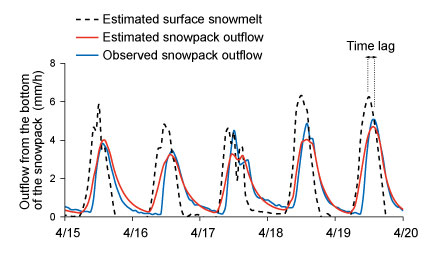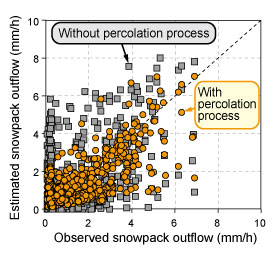6. Simple method for estimating outflow from beneath a snowpack
- A simple method has been developed to estimate the volume of snowmelt on the snowpack surface from commonly available meteorological data. This method is required for assessing risk of full-depth avalanches.
- By taking into account the percolation of water from melting snow into the snow layers, it was confirmed that this method can be used to estimate outflow from the bottom of a snowpack at 1-hour intervals.
The volume of outflow from the bottom of a snowpack during the snowmelt season, influences the occurrence of full-depth avalanches. In order to evaluate the risk of such an event, it is important to estimate the volume of outflow from the bottom of snowpack.
A simple method already exists for estimating snowpack outflow using just temperature, however, it only gives results for daily volumes, and there were problems using this method to evaluate the risk of avalanches. The method for estimating snowpack outflow on the other hand requires a large number of input data, and is therefore difficult to use in practice, during train operation. Consequently a proposal was made for a simpler method for estimating snowpack outflow, which could be used instead.
In order to estimate snowpack outflow at one hour intervals, in addition to accurately finding the volume of surface snowmelt, it is necessary to include percolation. The volume of surface snowmelt can be estimated using a heat balance model,taking observation results into account, and using four input elements, i.e. air temperature, precipitation, wind speed and hours of sunlight, which can be collected from the nearest AMeDAS.
The time lag for the percolation process can be estimated using a model calculation method for percolation speed using the previously obtained surface snowmelt as an input value, then applying this to the process for estimating snowpack outflow (Fig.1). Including the percolation time lag reduces the standard error in estimated values for snowpack outflow by approximately one half, compared with results where the percolation process is not factored in (Fig.2).

Fig.1 Variation in surface snowmelt , snowpack outflow
(period shown in example: 15 - 19 April (5 days))
Fig.2 The relationship between estimated
and observed snowpack outflow